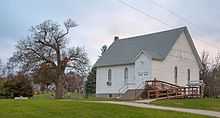Elkhart, Iowa
| Elkhart, Iowa | |
|---|---|
| City | |
|
| |
 Location of Elkhart, Iowa | |
| Coordinates: 41°47′34″N 93°31′30″W / 41.79278°N 93.52500°WCoordinates: 41°47′34″N 93°31′30″W / 41.79278°N 93.52500°W | |
| Country |
|
| State |
|
| County | Polk |
| Area[1] | |
| • Total | 1.58 sq mi (4.09 km2) |
| • Land | 1.58 sq mi (4.09 km2) |
| • Water | 0 sq mi (0 km2) |
| Elevation | 978 ft (298 m) |
| Population (2010)[2] | |
| • Total | 683 |
| • Estimate (2012[3]) | 691 |
| • Density | 432.3/sq mi (166.9/km2) |
| Time zone | Central (CST) (UTC-6) |
| • Summer (DST) | CDT (UTC-5) |
| ZIP code | 50073 |
| Area code(s) | 515 |
| FIPS code | 19-24735 |
| GNIS feature ID | 0456304 |
| Website | www.elkhartiowa.com |
Elkhart is a city in Polk County, Iowa, United States. The population was 683 at the 2010 census. It is part of the Des Moines–West Des Moines Metropolitan Statistical Area.
History
Elkhart was founded in 1853[4] by settlers from Elkhart, Indiana. It incorporated as a city on July 27, 1904.[5]
Geography
According to the United States Census Bureau, the city has a total area of 1.58 square miles (4.09 km2), all of it land.[1]
Demographics
| Historical Populations | ||
|---|---|---|
| Year | Pop. | ±% |
| 1910 | 132 | — |
| 1920 | 196 | +48.5% |
| 1930 | 218 | +11.2% |
| 1940 | 215 | −1.4% |
| 1950 | 222 | +3.3% |
| 1960 | 260 | +17.1% |
| 1970 | 269 | +3.5% |
| 1980 | 256 | −4.8% |
| 1990 | 388 | +51.6% |
| 2000 | 362 | −6.7% |
| 2010 | 683 | +88.7% |
| Source:"American FactFinder". United States Census Bureau. and Iowa Data Center | ||

2010 census
As of the census[2] of 2010, there were 683 people, 256 households, and 175 families residing in the city. The population density was 432.3 inhabitants per square mile (166.9/km2). There were 269 housing units at an average density of 170.3 per square mile (65.8/km2). The racial makeup of the city was 95.6% White, 1.0% African American, 0.3% Native American, and 3.1% from two or more races. Hispanic or Latino of any race were 3.8% of the population.
There were 256 households of which 46.1% had children under the age of 18 living with them, 54.3% were married couples living together, 8.2% had a female householder with no husband present, 5.9% had a male householder with no wife present, and 31.6% were non-families. 25.0% of all households were made up of individuals and 7.5% had someone living alone who was 65 years of age or older. The average household size was 2.67 and the average family size was 3.27.
The median age in the city was 30.6 years. 32.7% of residents were under the age of 18; 7.5% were between the ages of 18 and 24; 32.9% were from 25 to 44; 19.2% were from 45 to 64; and 7.6% were 65 years of age or older. The gender makeup of the city was 51.5% male and 48.5% female.
2000 census
As of the census[6] of 2000, there were 362 people, 158 households, and 91 families residing in the city. The population density was 306.3 people per square mile (118.4/km²). There were 163 housing units at an average density of 137.9 per square mile (53.3/km²). The racial makeup of the city was 98.07% White, 1.38% African American, 0.28% Native American, and 0.28% from two or more races. Hispanic or Latino of any race were 0.28% of the population.
There were 158 households out of which 24.7% had children under the age of 18 living with them, 46.8% were married couples living together, 8.9% had a female householder with no husband present, and 41.8% were non-families. 34.8% of all households were made up of individuals and 15.8% had someone living alone who was 65 years of age or older. The average household size was 2.29 and the average family size was 2.96.
22.9% are under the age of 18, 11.6% from 18 to 24, 32.3% from 25 to 44, 16.3% from 45 to 64, and 16.9% who were 65 years of age or older. The median age was 34 years. For every 100 females there were 96.7 males. For every 100 females age 18 and over, there were 96.5 males.
The median income for a household in the city was $33,000, and the median income for a family was $51,042. Males had a median income of $37,500 versus $23,438 for females. The per capita income for the city was $20,397. None of the families and 4.7% of the population were living below the poverty line, including no under eighteens and 8.6% of those over 64.
References
| Wikimedia Commons has media related to Elkhart, Iowa. |
- ↑ 1.0 1.1 "US Gazetteer files 2010". United States Census Bureau. Retrieved 2012-05-11.
- ↑ 2.0 2.1 "American FactFinder". United States Census Bureau. Retrieved 2012-05-11.
- ↑ "Population Estimates". United States Census Bureau. Retrieved 2013-05-23.
- ↑ The History of Polk County, Iowa: Containing a History of the County, Its Cities, Towns, &c. Union Historical Company. 1880. p. 643.
- ↑ Henning, Barbara Beving Long; Patrice K. Beam (2003). Des Moines and Polk County: Flag on the Prairie. Sun Valley, California: American Historical Press. ISBN 1-892724-34-0.
- ↑ "American FactFinder". United States Census Bureau. Retrieved 2008-01-31.
| |||||||||||||||||||||||||||||